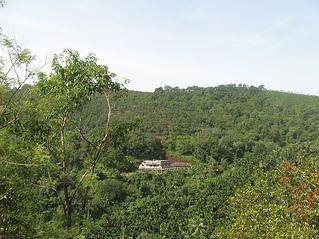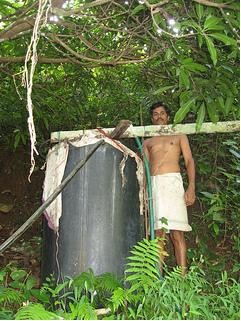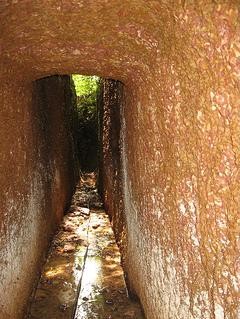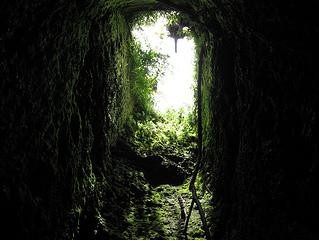Surangas continue to be one of the relatively less known and gradually disappearing traditional water harvesting systems of Kasargod district, Kerala and are being gradually replaced by borewells to meet the water needs of the community.
Surangas can be compared to a horizontal well or cave excavated in hard laterite soil formations from which water seeps out, and flows out of the tunnel to be collected in open ponds. Despite their decline, they continue to be a lifeline for a large number of farmers in Kasargod, who depend on surangas to meet their drinking water needs.
There is an urgent need to create awareness about restoring and reviving these traditional water harvesting structures that are not only far more sustainable in the long run than borewells, but carry with them the remnants of the age old wisdom of treating nature with respect and using natural resources wisely.

A view of Padre village in Kasargod district (Photo: Niranjan Khambete)
A glimpse of the beautiful village of Padre located in Kasargod district makes it very difficult to believe that this is the place where the endosulphan tragedy continues to leave its imprints on the people in the area. We have come here to visit Shree Padre ji, better known as the rainwater man for his pioneering work on farm journalism and documentation of traditional water harvesting methods for water conservation.
Padre ji continues to live in his native village and works on sensitising the communities on issues very close to the hearts of the farmers such as water conservation through revival of traditional water harvesting methods, documenting and sharing old and new methods and success stories by farmers on water harvesting and developing and propagating agricultural products for markets such as jackfruit. Besides this, he continues to direct attention and sensitise communities from Kerala and Karnataka on the endosulphan issue.
One of the important and relatively less known feature of Kasargod district includes its unique systems of traditional water harvesting that include the surangas or surangams. “People have been devising ways of harvesting water traditionally since a very long time and these methods have been passed on from generations to generations in different parts of the country”, Shree Padre ji informs us. “However, these are sadly being ignored and will probably gradually disappear over the years to come”, he adds.
“Traditional water harvesting systems provide very simple, age old time-tested solutions to the water scarcity problems that farmers have been facing in recent years and build on the concepts of community sharing, ownership, choice, and on the appropriateness and suitable use of resources in the long run. However, institutions that have nurtured these water harvesting structures seem to have disappeared and there are very few people who have the necessary skills to build these structures, which further leads to the possibility of this traditional knowledge being lost to history, over the years”, he says.
The surangas of Kasargod
People in Kasargod district in north Kerala cannot depend directly on surface water and the terrain is such that there is high discharge in rivers in the monsoon and low discharge in the dry months. People here have to depend on groundwater and use surangas or surangams, as specially devised water harvesting structures. The word suranga is derived from a Kannada word for tunnel. It is also known as thurangam, thorappu etc in Malayalam.
 A view from inside a suranga (Photo: Shree Padre)
A view from inside a suranga (Photo: Shree Padre)
A suranga can be compared to a horizontal well, or better a cave, mostly excavated in hard laterite soil formations. The excavation continues until a good amount of water is struck. Water seeps out of the hard soil and flows out of the tunnel. This water is usually collected in an open pond constructed outside the suranga. A suranga is about 0. 45 - 0.70 metres (m) wide and about 1.8 - 2.0 m high and the length can vary from around 10 to 300 metres.
In some cases, several subsidiary surangams are excavated inside the main one. If the surangam is very long, a number of vertical air shafts are provided to ensure atmospheric pressure inside. The distance between successive air shafts varies between 50-60 m. The approximate dimensions of the air shafts are 2 m by 2 m, and the depth varies from place to place [1].
Surangas can be compared to qanats, which once existed in Mesopotamia and Babylon around 700 BC. This technology later spread to Egypt, Persia (now Iran) and India. The initial cost of digging a surangam can be around (Rs 100-150 per 0.72 m dug) and is the only expenditure needed, as it hardly requires any maintenance. Traditionally, a surangam is excavated at a very slow pace and would take generations to complete [1] .
A visit to Padre village in Kasargod
We visit Kishore ji, a farmer in Padre village and his father, Vishwanath ji, who is about 82 years old, with the house name of Vishwa Bharati Nilaya. Kishore ji's family has been using water from the suranga dug near his house since the last 20 years, that he thinks has been constructed some 35 to 40 years ago. "We are Karhad brahmins, and migrated here originally from Maharashtra", he informs, "and we depend exclusively on surangas to meet our daily drinking water needs. We never use open wells for drinking water since we consider the suranga water as shuddha (pure) and cool.
"There are around 80 to 100 houses of Karhad brahmins in this village. Most of the households do not have an open well and depend on surangas to meet their drinking water needs. For irrigation, we resort to open wells ", he adds. "We have had a good rainfall this year. Suranga water is not available normally during summer, but we also had water in summer this year", he informs happily.

A smaller suranga used by Kishoreji from Padre village (Photo: Shree Padre)
We go to see the suranga located slightly high up in the hills away from his house. This looks like a smaller one, very narrow and difficult to get inside. We peep inside to get a view, we feel the hard and rough walls and see water streams coming out from this small cave like structure. Kishore ji shows us the connected pipe that carries this water seeping through the suranga to a tank at the lower level near his house for storing this water, which he uses for household purposes. We also see a pond near his house that he uses to irrigate his arecanut plantations.
"Digging a suranga is a highly skilled job and is done only during summer. The unit of measurement is a kolu. It is very difficult to get skilled labourers these days to dig a suranga", he tells us. "It is very important to keep the suranga clean, we have to see that there are no shrubs. And crabs can sometimes create a huge menace", he adds. We take his leave after taking in the view of the beautiful arecanut plantations and the fresh green smell of the fields, touched by his hospitality.

Kishoreji near the tank that collects water from the suranga, which he uses for his household (Photo: Niranjan Khambete)
Our visit to Maire village
We decide to have a look at another bigger suranga in Maire village a few kilometres away from Padre village. We first meet Ravindranath Nayak ji, headmaster of the Sri Sharadamba High School, Sheni in Maire village who knows all the details of the suranga and is familiar with its structure and informs us that this suranga has been built by his grandfather. He informs us that the suranga that we will be seeing is around 80 years old and is 300 metres long with six air-vents.
He guides us to the suranga, which looks almost as big as a cave in which a person can easily enter. We touch the walls, feel the golden yellow rock texture and find it to be moist and rough. We debate over whether to go inside and finally give in. As we walk inside the suranga, we can feel the steady flow of the very clean water under our feet, a few pebbles, rocks, but no moss with occasional frogs jumping around. We keep on going inside the tunnel, and have to use a torch, the flow of water increasing and the water getting slightly deeper.
We have to mind our heads as the tunnel gets deeper till we see light coming in from the air-vent of the suranga, a well like structure with walls opening out on to the surface surrounded by thick shrubs and small plants that we can see from below with hanging tree roots reaching towards us, completing the picture.

The inner view of the bigger suranga in Maire village (Photo: Shree Padre)
We come across heaps of plastic bags, bottles thrown in by people in the air vent, choking and restricting the flow of water and indicating how disrespectful we have gradually become of the efforts and traditional wisdom of our ancestors and to the value of the resources like water, flowing naturally and unrestrictively, but on the verge of becoming scarce very soon.
The urgency to create awareness amongst people on the value of these traditional water harvesting structures seems to be even more, as more and more of these structures continue to disappear, taking along with them the remnants of the valuable age old traditional wisdom passed on from generation to generation, of working along with nature, not by harnessing it, but by understanding and using resources wisely and with great respect.

A view of the air vent/shaft of the suranga from Maire village from below (Photo: Niranjan Khambete)
We decide to go back and outside the suranga and trace the suranga from this outlet through the six vents to the other end at the other side of the village. We visit a tea shop near one of the air vents of the surangas. Ramakrishna Nayak ji, who has been running the shop since the last ten years informs us that this was an isolated place with very few families earlier and he used to draw water from this air vent. But now, waste is put into this air-vent, once it is disused, the tendency to disuse it is even more, he adds. The village has borewells now and people use this water.
 A view of the suranga air shaft from Maire village from the top (Photo: Sree Padre)
A view of the suranga air shaft from Maire village from the top (Photo: Sree Padre)
We return with a heavy heart back to our car. We notice a few taps and a hand pump on the way back that have been installed to provide water to the village. We try to use the hand pump and open the taps. There is no water in the taps !
Acknowledgements
The author is extremely thankful to Shree Padre ji for providing an overview of the water and agriculture related issues in Kasargod district, for informing and educating her on the importance of surangas as traditional water harvesting structures, taking her to the villages to view the surangas and to meet the villagers in the area, as well as for providing his valuable inputs and suggestions on this write up.
The author is also thankful to Kishore ji from Padre village and Ravindranath Nayak ji from Maire village for their valuable time and for taking us to see the surangas. The author is also thankful to Shree Padre ji and Niranjan Khambete for the photographs.
Kishore ji from Padre village can be contacted at this number: +91-9495371158; Ravindranath Nayak ji, Headmaster of Sri Sharadamba High School, Sheni can be contacted at this number: +91-9846965309.
References
- Centre for Science and Environment(2012), Surangams, downloaded from the website, http://www.rainwaterharvesting.org/Rural/Traditional3.htm#sura, on 30th September 2012
- Articles by Shree Padre on surangas can be accessed at the links below:
- Padre, Shree (2010), Farming without pumps, Leisa India
- Padre, Shree (2009), The unique water tunnel of Sheni, India Together
- Padre, Shree (2008), A Gurukula for surangas, India Together
- Padre, Shree (2006), Surangas, manmade caves to tap underground water, India Together
- Padre, Shree (2006), Don't dig down, India Together
/articles/surangas-disappearing-lifeline-farmers-kasargod-kerala